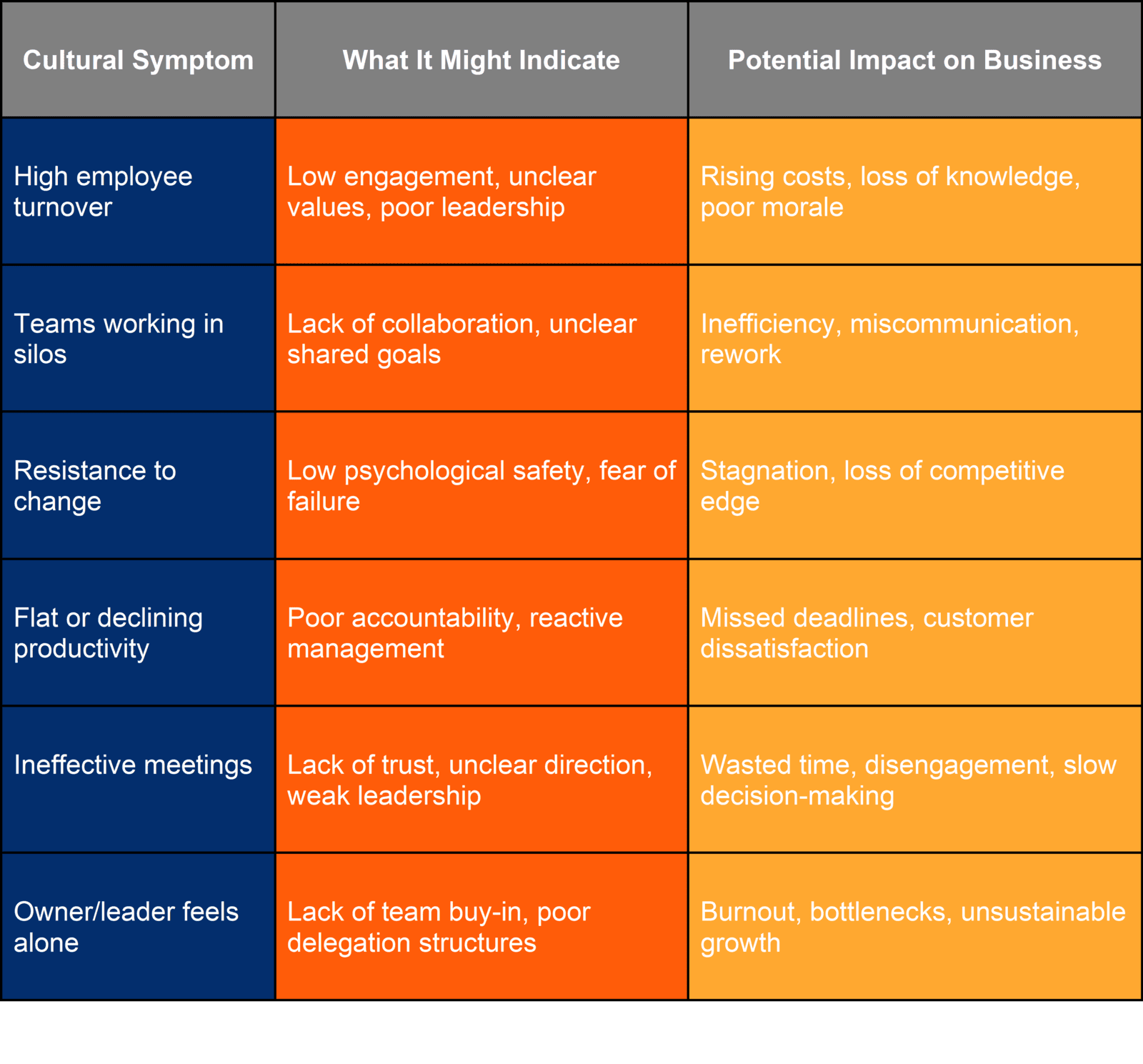Culture Isn’t Soft – It’s Strategic

For many Canadian business owners, culture can often feel like a “soft” issue — something that’s important, sure, but not nearly as critical as operations, financials, or customer satisfaction.
But here’s the reality: Poor team culture isn’t just a people’s problem. It’s a business risk.
When culture is off, productivity stalls, innovation dries up, employee turnover rises, and leadership becomes reactive instead of strategic – these effects compound quickly.
In this post, we’ll explore the most common signs that your company culture might be quietly holding your business back and how to turn things around.
Why Culture Is More Than Just “Team Vibes”

Culture shapes how your team communicates, solves problems, handles stress, and embraces (or resists) change. When your culture is strong, your team moves with purpose. When it’s weak or misaligned, even the best strategy can fall flat.
A Gallup study found that companies with highly engaged teams see 21% greater profitability,
For many businesses, culture shows up in simple, everyday ways:
- Whether employees show up early, on time, or late.
- Whether they take ownership or pass the buck.
- Whether they care about doing the job right — or just doing it fast.
Let’s break down the red flags.
Spotting the Signs: What to Watch For
Here’s a quick reference table that outlines common warning signs and what they often point to in a business setting. You don’t need to tackle everything at once but being aware is the first step to driving meaningful culture change.
6 Signs Your Team Culture May Be Holding You Back
1. Good Employees Keep Leaving
Turnover isn’t always about pay. If your best people are walking out the door, it’s time to dig deeper.
According to a LinkedIn Workplace Culture report, 70% of professionals said they would not work at a leading company if it meant dealing with a toxic culture.
In small-to-midsize teams, even one departure can disrupt operations. High turnover usually signals that employees feel undervalued, unheard, or disconnected from leadership.
What to look for:
- Exit interviews that mention poor communication or favoritism.
- Increasing reliance on temp workers or contractors.
- "It’s just a job" attitudes among senior employees.
2. Silos Are Sabotaging Your Progress
When teams or individuals start operating in isolation, it’s a sign of deeper misalignment. Silos reduce collaboration, duplicate work, and slows down decisions.
Example: In a construction business, if the sales team promises faster delivery than the operations team can realistically manage, customer trust — and team morale — suffers.
What to look for:
- Lack of shared goals across teams.
- Conflicting priorities (e.g., project speed vs. safety).
- A blame-heavy environment when things go wrong.
3. Change Feels Like a Fight, Every Time
Change is hard. But if every improvement effort gets met with resistance, your culture might be stuck in survival mode.
Psychological safety — the belief that people can take risks or suggest improvements without fear — is essential to building resilient teams. Without it, people default to "how we’ve always done it."
What to look for:
- “We tried that before, and it didn’t work” mindsets.
- Employees are afraid to ask questions or make suggestions.
- Leaders need to push change rather than inspire.
4. Performance Has Plateaued
If productivity has flatlined but your team is busier than ever, culture could be the silent culprit.
This is common in businesses that grew quickly but didn’t invest in clear systems, training, or accountability. The result? A reactive team that’s always putting out fires.
McKinsey & Company reports that companies with strong organizational health, culture included, outperform peers by 2x on EBITDA.
What to look for:
- Low accountability (“That’s not my job”).
- Leaders doing too much of the day-to-day.
- Staff confusion about who’s responsible for what.
5. Meetings Go Nowhere (or Happen Way Too Often)
Meetings should align people and move projects forward. But in cultures lacking trust or direction, meetings become performative or conflict-ridden.
You know it’s a problem when meetings are full of vague updates, defensive tones, or “meeting after the meeting” chats in the hallway.
What to look for:
- Repeated complaints about meeting frequency or length.
- People are disengaged or distracted during discussions.
- No clear action items or follow-through.
6. You’re the Only One Who Seems to Care
This one stings. Many business owners pour their heart into the company, only to feel like no one else is carrying that same weight.
The problem is not laziness — it’s often the lack of clarity, purpose, or trust in leadership.
What to look for:
- Unclear goals or values.
- Employees disconnected from the business mission.
- Lack of individual or team ownership and accountability.

Turning Culture into a Strategic Advantage
If any of these signs feel familiar, you’re not alone. The good news? Culture is changeable – with intention and action.
Here’s how to get started:
1. Assess Honestly: Use simple tools like anonymous pulse surveys or one-on-one check-ins to understand what’s working — and what’s not.
2. Reconnect to Purpose: Remind your team why your business exists, what values matter most, and how their work connects to real impact and contributes to your mission.
3. Build Leadership Capacity: Even the best strategy fails without strong leadership. Invest in leadership coaching and development for yourself and your managers.
4. Create Systems That Reinforce Culture: Culture doesn’t live in posters — it lives in your hiring, onboarding, performance reviews, and daily habits.
5. Recognize and Reward the Right Behaviors: Celebrate small wins, team contributions, and examples of people living your values — not just hitting targets.Real-World Example: A Construction Team Gets Unstuck
Meet Alex, the owner of a mid-sized HVAC business. Like many business owners, Alex had built his company from the ground up with hard work, grit, and strong skills. But over time, cracks started to show like many of the challenges listed above: high turnover, blame culture, and stalled growth. Alex was feeling like he was carrying the weight of the business alone.
At first, Alex thought the solution was simply hiring more staff. But after stepping back, he realized the true issue wasn’t headcount — it was culture. With some coaching, Alex decided to make a few key shifts:
- Introduce weekly crew check-ins focused on both wins and bottlenecks.
- Rebuild their onboarding process to reinforce values from day one.
- Create peer mentorship roles to support new hires.
The result? Within a few months Alex saw major improvements.
- Turnover dropped significantly as employees felt more connected and supported.
- Job completion times improved due to better communication and fewer mistakes.
- Team morale increased and so did Alex’s — he was now feeling “re-energized and supported, not alone anymore.”
The best part? He didn’t need a full overhaul! A few focused culture shifts created a ripple effect that transformed the team’s performance — and Alex’s leadership experience as well.

Lead with Culture, Grow with Confidence
Culture isn't fluff — it’s a foundation.
If you're noticing signs of friction, disconnection, or stalled growth, it's worth exploring whether culture is the missing piece.
You don’t have to fix it alone.
At Blueneck, we help business owners across Canada build stronger leadership, stronger teams, and stronger businesses — without jargon, judgment, or jumble. We believe that with the right guidance, any team can get back in sync and move forward with confidence.
Ready to Build a Stronger Culture?
Let’s talk about how your culture could be driving — or dragging — your business forward.
Contact us to learn more and book a discovery call.

